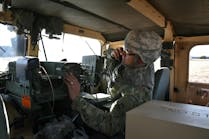By Bob Scannell
Precision navigation aids are essential for aviation and smart munitions, as well as in autonomous land vehicles, robotics, and personal locators, to name just a few.
For years the solution of choice has been the highest precision inertial measurement units (IMUs), such as ring-laser or fiber-optic gyros. While these solutions provide good performance, they place a heavy tax on the rest of the system budgets, including cost (thousands of dollars), power, and size.
The maturing of gyro technology based on microelectromechanical systems (MEMS) in the last few years has lead some systems designers to re-examine their approach to guidance-system design, primarily because of an order-of-magnitude savings in cost, along with attractive size and power advantages. The challenge for designers is to reallocate system performance budgets and to design-in additional performance rather than relying solely on the core IMU. Designers who are successful find that the cost advantages also open up many new application opportunities.
MEMS-based gyros, like accelerometers, are accepted as an essential element in automotive safety systems and are a mature and reliable technology. They are commonly used in electronics vehicle stability control and automobile navigation.
Car navigation units combine accelerometers and gyros for a dead-reckoning function that backs up the GPS signal in case it is temporarily lost. This approach of combining of several sensors-inertial, global-positioning system, magnetometer, and visual-is a key element in extending the technology to precision military applications.
Gyro bias stability will receive much of the focus in any design analysis. Because military equipment designers have come to expect gyro stability in tenths of degrees or degrees per hour, a tens-of-degrees-per-hour performance level may seem unacceptable to some. Others, however, have succeeded in working with these performance levels and have achieved the desired performance at the system level.
Many gyros have inherent biases and sensitivities to temperature, voltage, vibration, and other influences. Automotive manufacturers working in million-unit quantities can cost-effectively implement the necessary test and calibration into their production flow. However, for others operating at relatively low production volumes the infrastructure to implement motion (rotating test platforms, etc.) is a barrier.
Some gyro manufacturers recognize this need and provide precalibrated, system-ready components. Depending on the sophistication of the factory calibration and the level of semiconductor integration around the gyro, these components can substantially improve the in-system bias stability.
Choosing a precision-calibrated gyro is crucial to providing at least short-term stability, but the designer needs to also consider alternative filtering approaches and sensor combinations to achieve the needed long-term stability.
Producing a six-degree-of-freedom inertial sensor is a particularly challenging problem, for which semiconductor technology alone can be insufficient.
Achieving high accuracy across several sensing axes today requires module-level integration. To avoid excessive cost overhead at the module level, it is important to carefully consider materials and processes. A good balance between cost, performance, and ease-of-use is even more important in addressing a substantial market.
Perhaps the most significant challenge is in the module test. A sophisticated combination of electrical and mechanical tests must be engineered to cross-compensate several sensors, correcting for all significant electrical, positional, and motion influences.
The desired outcome is a guidance device illustrated in the figure. Performance as shown in the table is achievable today, with further improvements in stability on the horizon. When such devices, such as Analog Devices’s ADIS16350, can hit a price target below $300.
Bob Scannell is the business development manager for at the Analog Devices Inc. iSensor products segment in Norwood, Mass.




